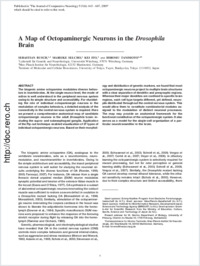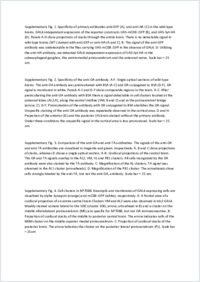A map of octopaminergic neurons in the Drosophila brain
- Busch, Sebastian Lehrstuhl für Genetik und Neurobiologie, Universität Würzburg, Germany - Max-Planck-Institut für Neurobiologie, Martinsried, Germany
- Selcho, Mareike Lehrstuhl für Genetik und Neurobiologie, Universität Würzburg, Germany - Department of Biology, University of Fribourg, Switzerland
- Ito, Kei Institute of Molecular and Cellular Biosciences, University of Tokyo, Japan
- Tanimoto, Hiromu Lehrstuhl für Genetik und Neurobiologie, Universität Würzburg, Germany - Max-Planck-Institut für Neurobiologie, Martinsried, Germany
-
20.02.2009
Published in:
- The Journal of Comparative Neurology. - 2009, vol. 513, no. 6, p. 643 - 667
English
The biogenic amine octopamine modulates diverse behaviors in invertebrates. At the single neuron level, the mode of action is well understood in the peripheral nervous system owing to its simple structure and accessibility. For elucidating the role of individual octopaminergic neurons in the modulation of complex behaviors, a detailed analysis of the connectivity in the central nervous system is required. Here we present a comprehensive anatomical map of candidate octopaminergic neurons in the adult Drosophila brain: including the supra- and subesophageal ganglia. Application of the Flp-out technique enabled visualization of 27 types of individual octopaminergic neurons. Based on their morphology and distribution of genetic markers, we found that most octopaminergic neurons project to multiple brain structures with a clear separation of dendritic and presynaptic regions. Whereas their major dendrites are confined to specific brain regions, each cell type targets different, yet defined, neuropils distributed throughout the central nervous system. This would allow them to constitute combinatorial modules assigned to the modulation of distinct neuronal processes. The map may provide an anatomical framework for the functional constitution of the octopaminergic system. It also serves as a model for the single-cell organization of a particular neurotransmitter in the brain
- Faculty
- Faculté des sciences et de médecine
- Department
- Département de Biologie
- Language
-
- English
- Classification
- Biological sciences
- License
-
License undefined
- Identifiers
-
- RERO DOC 11675
- DOI 10.1002/cne.21966
- Persistent URL
- https://folia.unifr.ch/unifr/documents/300995
Other files
Statistics
Document views: 141
File downloads:
- pdf: 578
- Supplementary material: 144

